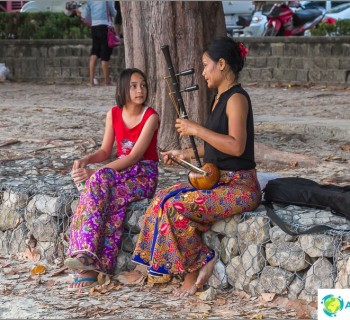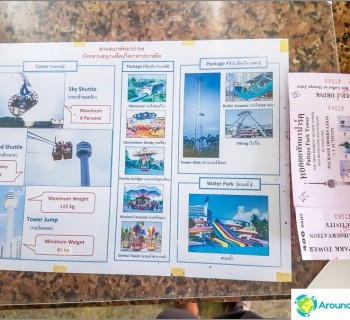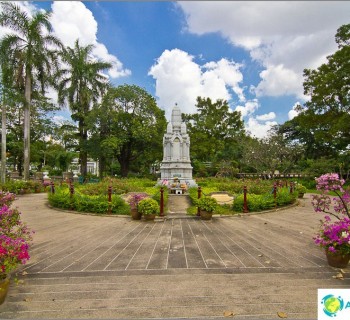It's no secret that Daria and I have been looking closely at the countries of Eastern Europe for a long time in order to live there for some time or even emigrate. This is very convenient, since the flight to Moscow takes only a few hours, you can live here and there in Russia, depending on the season and all sorts of different things that arise. That is why I am interested in similar comparisons from people (guest posts) who have visited Thailand, and then moved somewhere else..
Let me remind you that we already have stories about Mexico, eco-village in Latvia, Cambodia, Vietnam. And there is also some more information on Residence permit in different countries with interesting comments at the end of the post.
The content of the article
- one What is the post about
- 2 How we lived in Thailand and then ended up in Serbia
- 3 Thailand VS Serbia
- 4 Wintering VS moving
What is the post about
This article is a comparison of life in Thailand and Serbia, as we managed to live a little both there and there. For us - this is little Sophia, Oksana and Sergei. Those who are interested in this European country, I invite to my blog «Around the World of Sofia», let's be friends on Facebook and Vkontakte, so as not to get lost.
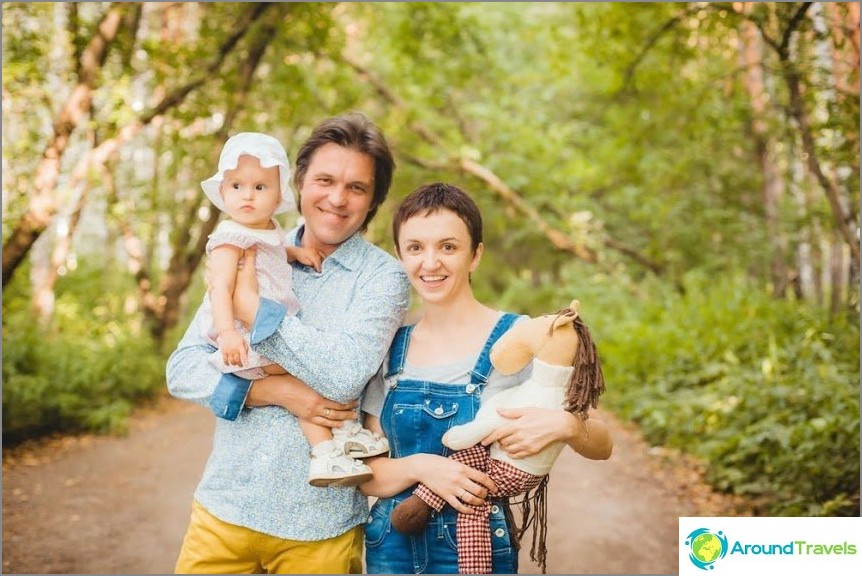
Last winter, we spent six months in Thailand, in Krabi. And now I am writing this article in Serbia in the city of Novi Sad. This is a comparison not only of two countries, but, as it turns out, two slightly different lifestyles, since in Thailand we rented a house, and in Serbia we bought an apartment.
I will tell you why we decided to move to Serbia, and also try to compare the pros and cons of living in these countries. I must say right away that since you can find any information in Oleg's blog on Thailand, I will give you the data on this country briefly. More information on Serbia.
How we lived in Thailand and then ended up in Serbia
The last time in Thailand we lived in the winter of 2013-2014, having arrived here with a three-month-old Sofia. Before that, we traveled in Asia since 2009, interrupting only for the time of the birth of the child..
The kid is a great opportunity to live, finally settled, we have long dreamed of renting a house in Thailand.
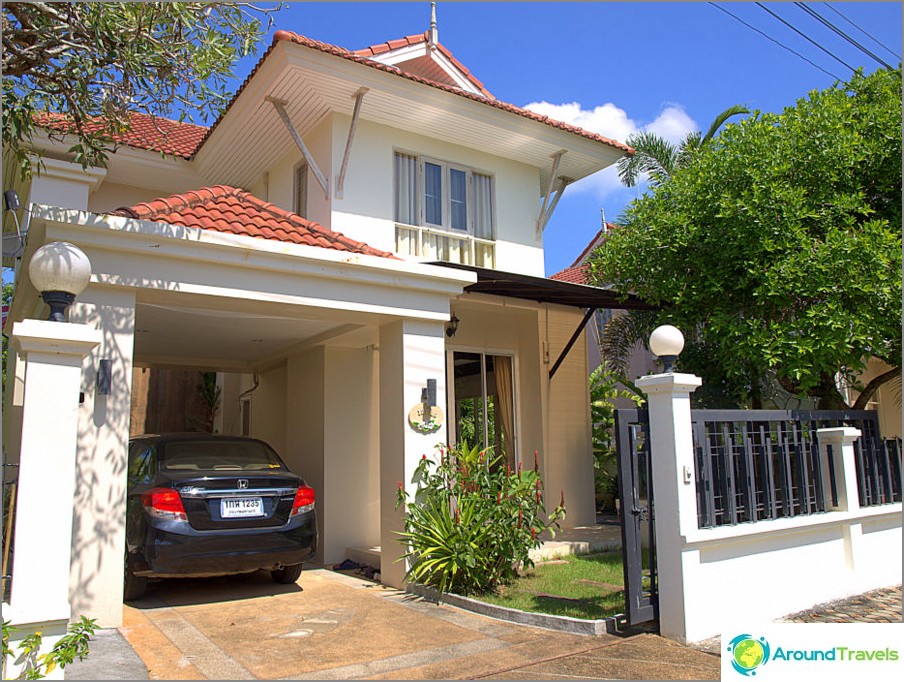
Our home in Thailand
We were very lucky and at the height of the season in the village of Ao Nang Gadn we found a beautiful house, despite the fact that almost a month before that we had been unsuccessfully looking for something good. Three bedrooms, a garden of a couple of acres, a communal pool and a gym, a very beautiful and comfortable village. We signed a house contract for a year and wanted to spend the whole year here.
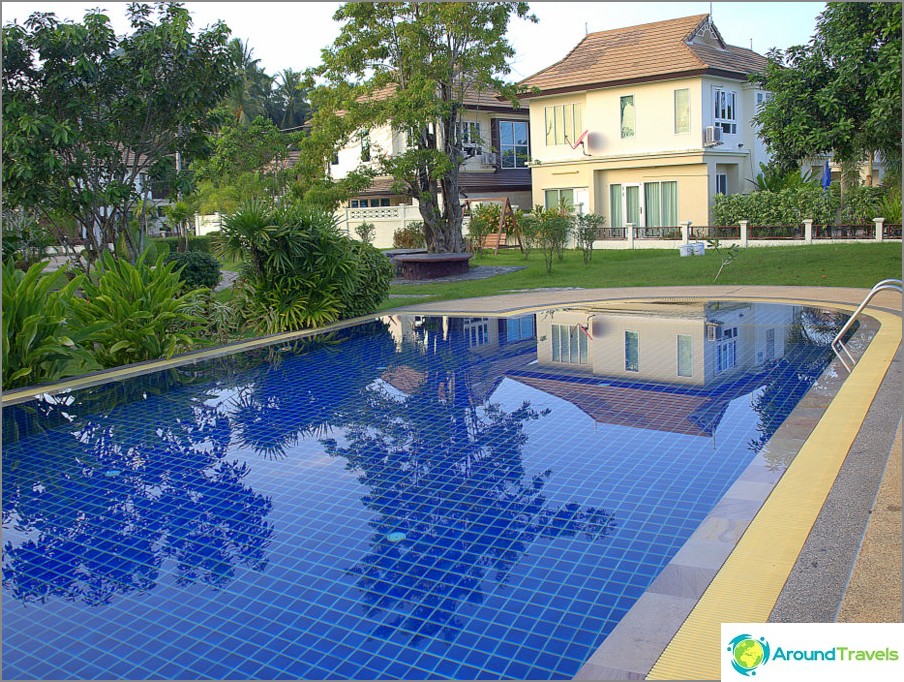
The pool of our village
It was very cool in Thailand:

But we had a persistent feeling that we were wasting time, since there are almost no hopes of settling here completely for many reasons, and we do not want to live in Russia for a long time, even only in summer.

Ao Nang Gadn - it's really very beautiful here
In Thailand, you can buy a house, open a business, but there is a feeling that you will always be here on a bird's side. A separate headache - visas, whatever one may say, still turn out to be a farang tourist. Therefore, somewhere in March, we thought about moving to Europe and returned to Russia in early April. There were several tasks: to decide on the country, to sell property in Russia, to get rid of things, etc. Moreover, in the spring there was an increase in currency rates.
There were several candidate countries: Italy, Slovenia and even Chile. In Italy and Slovenia, it would be necessary to open companies; in Chile, you can live on a rentier visa. Even on a rentier visa, you can live in France and Greece, once we also considered such options. In Montenegro and Cyprus, real estate is very expensive to buy, so these options disappeared right away.
Almost all options in Europe turned out to be very expensive, with the exception of Serbia and Bulgaria. Chile is a separate story altogether: you need to learn Spanish, fly far and expensive, and life there as a whole, in the end, seems to be more inconvenient and more expensive than in Europe.
The option with Serbia was outlined as the last one, I accidentally found out that in this country you can get a residence permit by buying real estate, it was in September 2014, and we ended up here just a month and a half later..
We didn’t hesitate for a long time, we didn’t dig into the forums especially, we just decided to go. In such a situation, both the lack and the excess of information are only harmful, because you begin to succumb to someone else's opinion, hesitate, and again the story does not go further than conversations. By the way, the situation when we also went to live for a long time, but we did not like it and we left, was already with us: in the Philippines.
In short, Serbia suited us perfectly in all respects, and we decided to stay. We have already bought an apartment here and issued a residence permit. But then I will try to compare life in Thailand and Serbia, with the pros and cons that I managed to understand.
Thailand VS Serbia
Visa regulations
Thailand: I think everyone knows about Thai visas. The rules are becoming stricter, although one-time and student visas can be obtained. Those who are over 50 can live on a retirement visa, another option is the Tai Elite card (now there is even a light for 500 thousand baht for several years), but among my acquaintances there is no such card.
Here is a person who writes about the experience of obtaining a residence permit in Thailand. The cost is 400 thousand baht for 3 years. For me, that's a lot. And the process itself is not very simple..
Serbia: It is relatively easy to get a residence permit, permanent residence here. Obtaining citizenship is a difficult and long process, but permanent residence in 5 years is already good.
It is clear that this lightness is relative, just like that, no one gives anything here. To obtain a residence permit, you can buy real estate or register a company. Marriage with a Serb or language courses are also an option, but more rare. Language courses for a visa are expensive (somewhere from 500 euros for six months) and a visa is given only for the period of study.
Having a residence permit in Serbia, you can, for example, get a Schengen visa, which means you don't go to Russia for it, especially since getting visas here seems to be easier..
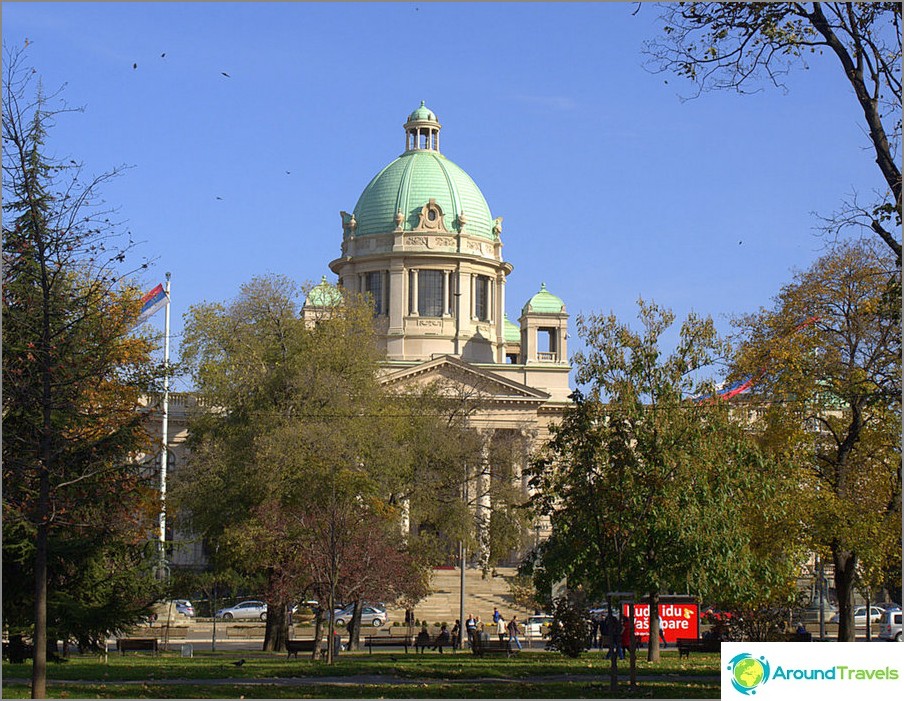
Belgrade, Parliament
It is also possible not to emigrate to Serbia, to live for some time on a visaran, just like in Thailand. But since there is a smaller scale (from Novi Sad to the border with Bosnia, which is visa-free for Russians, but, however, visa for Belarusians, only 40 km), it looks more like an easy walk. In Thailand, for this we drove 750 km ...
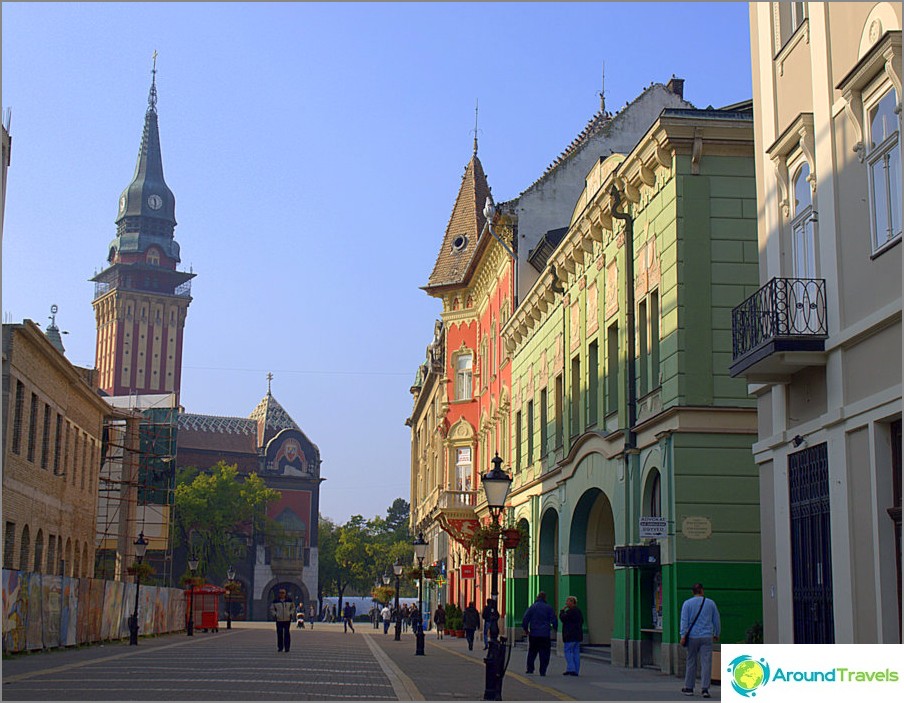
Subotica town
Also, taking into account the friendship between Serbia and Russia, an unprecedented privilege has been established for Russians: the number of visarans per year is not limited, for everyone else it is only 90 days in half a year. This is established by a bilateral international agreement, and they take precedence over local laws..
But in fact, people usually still try to apply for a residence permit, since the life of a visa does not count towards the period for obtaining permanent residence.
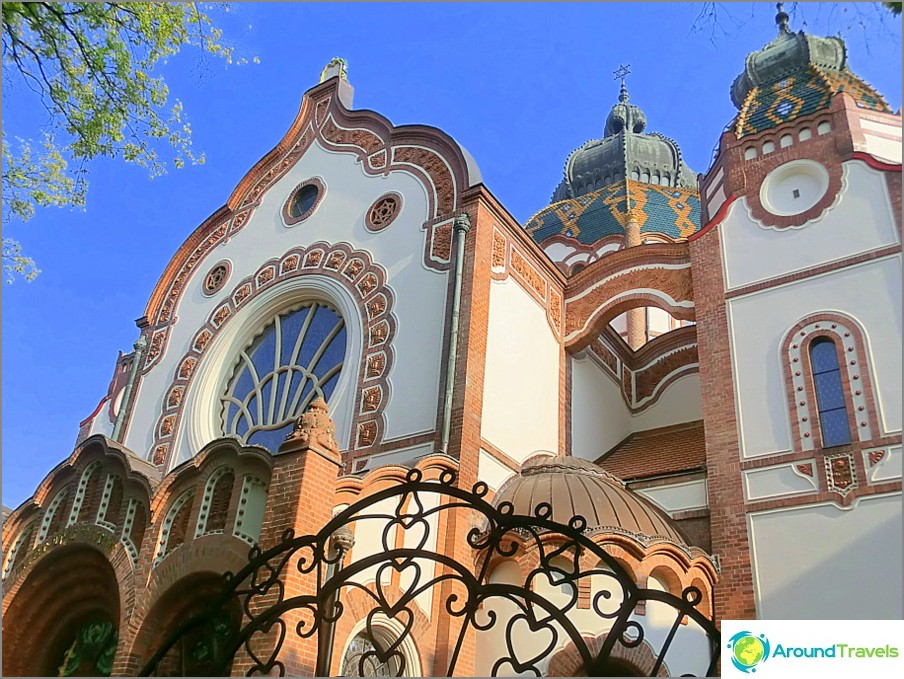
Very elegant synagogue in Subotica
Real estate prices and the rights it gives
Thailand: In Pattaya, you can still buy a small studio for 700-800 thousand baht (about 20 thousand euros). The house can be bought for about 3 million baht. In Bangkok, housing costs from 70 thousand baht per meter, on the outskirts. Home rentals: well, let's say an average of 15,000 baht per month.
Real estate ownership is not a basis for obtaining tourist visas, residence permits and permanent residence.
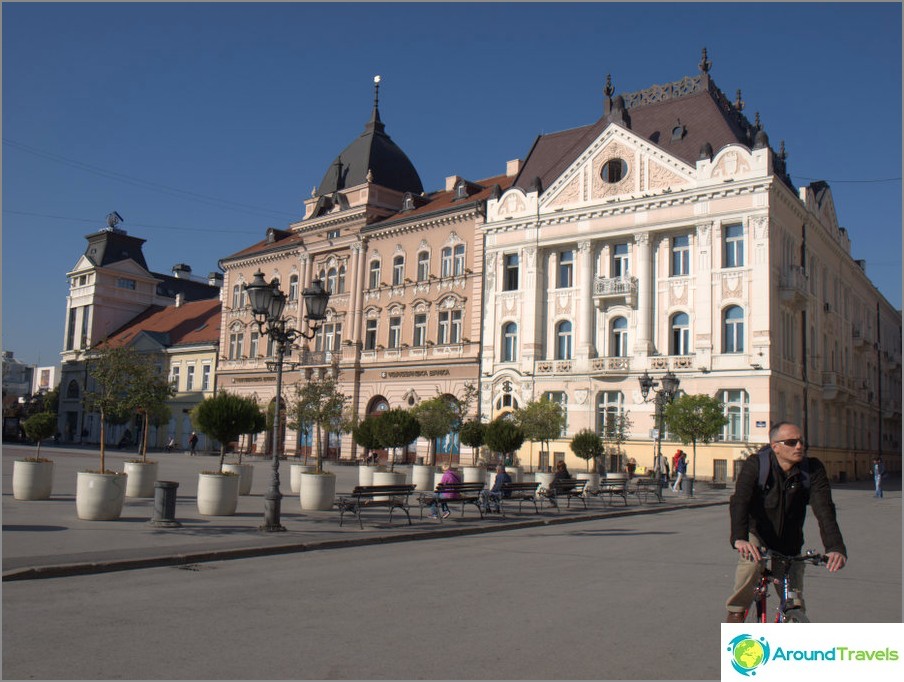
Center of Novi Sad
Serbia: Here a decent studio 28-30 meters in the city of Novi Sad will cost 20 thousand euros (from 800 euros per 1 sq. M). In the small town of Subotica, right on the border with Hungary, apartments are even cheaper. In Belgrade, the capital, on the contrary, it is more expensive - even on the outskirts of about 1300 euros per square meter.
As for the houses, for 30 thousand euros you can buy a good weekend, something like a summer cottage, but with a large plot, the house can be decent in size, but not insulated. From 50-60 there are good houses where you can live all year round. These are the prices for houses in the vicinity of Novi Sad.
If we go south, beyond Belgrade, it’s cheaper there, but we didn’t want to settle there. The nature is beautiful, but these areas were once conquered by the Turks, and the province of Vojvodina, where Novi Sad is located, is the former Austria-Hungary. You can feel it both in architecture and culture.
In general, real estate in Serbia is slightly more expensive than in Thailand. But it is also more capital, in comparison with Thai, since the climate here is not tropical and in winter there is a minus. Serbia has a lot of low-rise, small-apartment housing, in contrast to the large number of giant Thai condos, which is a plus. But as for ordinary houses, buying a house in Serbia is often a pig in a poke, since all the houses here are self-built.
In Thailand, on the contrary, you can buy a house in a village with a centralized development. We lived in this, we liked it. And from the point of view of compliance with construction standards, this is better than unauthorized construction. But, unlike Thailand, in Serbia, having bought real estate, you can get a residence permit and permanent residence.
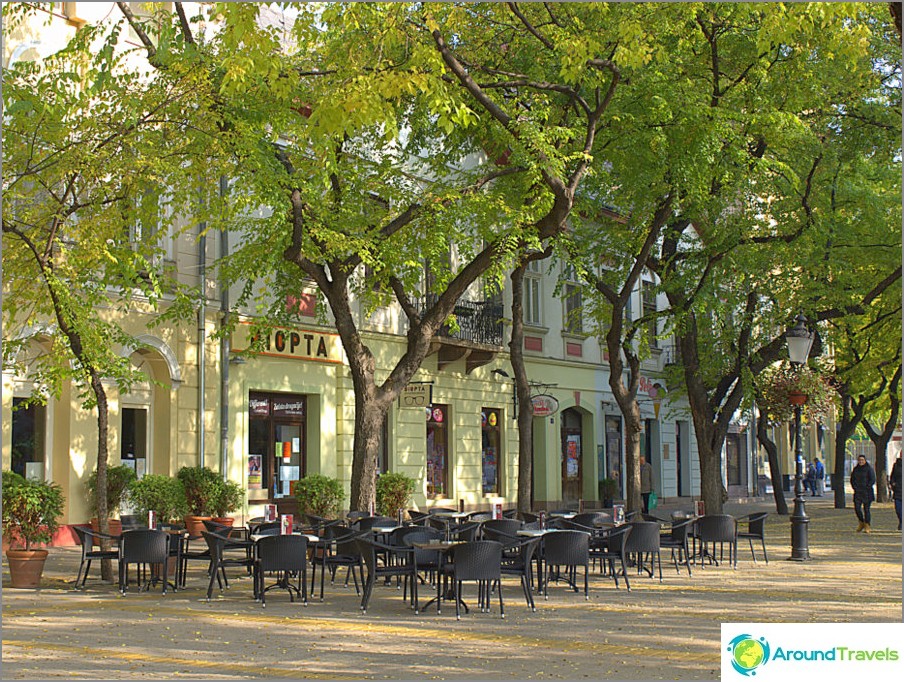
Coffee shops in Subotica
On average, the quality of new housing in Serbia is very good. For example, we bought an apartment in Novi Sad, 110 meters in a completely new house from a very good developer, for about 830 euros per meter, close to the city center. The apartment was with excellent finishes and all the fixtures and fittings. Warranty for everything, including faucets, 2 years. Bamboo parquet flooring, Velux roof windows, Schindler elevators, granite floor in the entrance. All this cost us 830 euros per square meter plus 5 thousand for an underground garage.
And closed courtyards, video surveillance, combination locks are a common thing here..
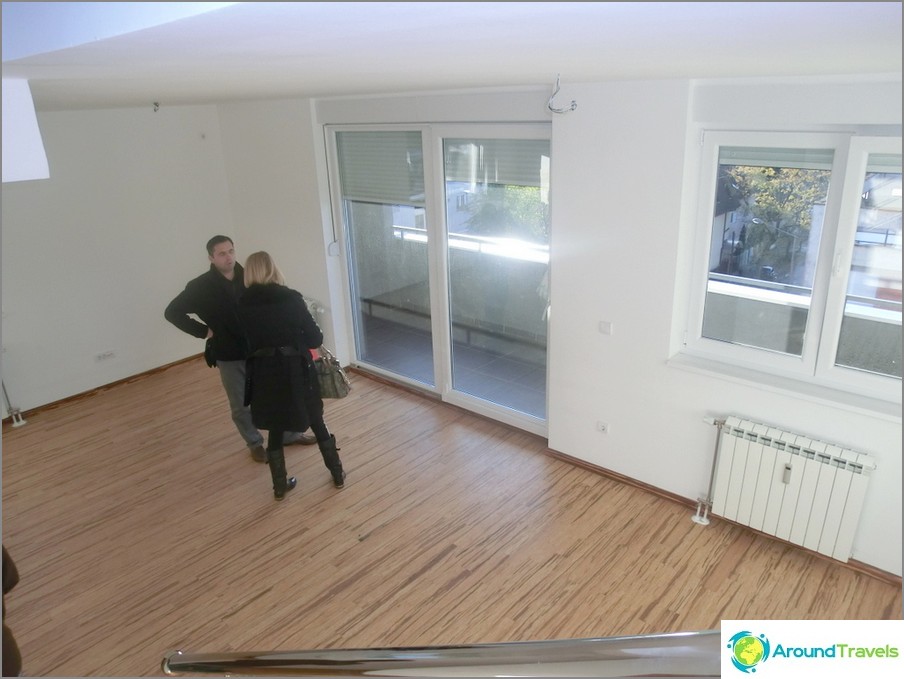
We are looking at apartments, this is a two-story duplex
Small apartments are good too. 37 meters here - this is an apartment with a separate bedroom and a room in which the kitchen area is allocated. In fact two-room.
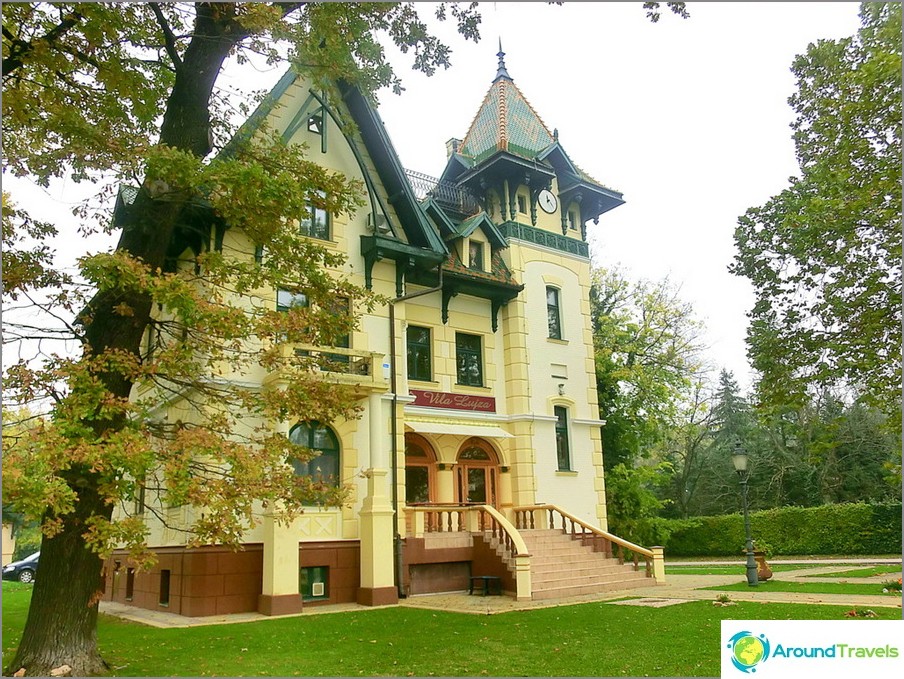
Hotels in Palić resort, on the border in Hungary, once part of Hungary
As for rent, a two-bedroom house can be rented for about 200 euros and for the same one-bedroom apartment, plus about 100 euros for a communal apartment, if for a long time. For a short (for a month) a little more expensive.
For lovers of luxury, there are also conditions here. There are also good plots in beautiful places, surrounded by mountains, next to the Fruska Gora nature reserve, and beautiful, expensive houses.
Sea
Thailand: What can I say? The sea and beaches are beautiful here. Even if they are not the same everywhere.
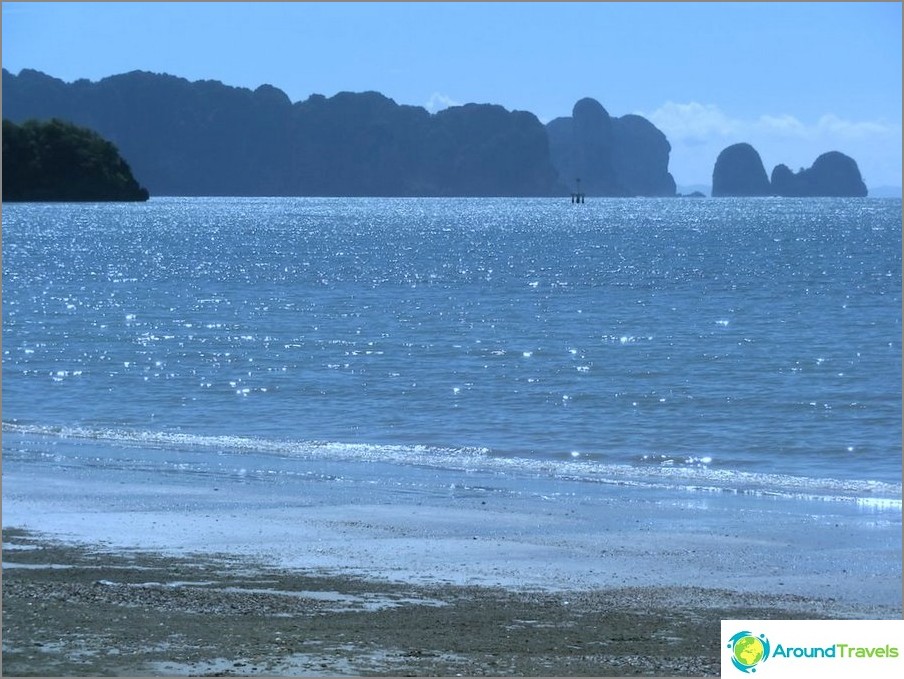
Long Beach in Krabi
Serbia: Its sea is not here. But there are a lot of seas nearby to choose from: Adriatic, Mediterranean, Black; and resorts: Greece, Croatia, Montenegro, Bulgaria, Italy.
You can go by car and fly by plane, since there are many low-cost airlines in Europe, you can always plan a trip for some kind of promotion. For me, it's better to go to the sea for a week once every two to three months, but not interfere with work, as is often the case in Thailand, when you stop going to the sea after about a month.
In addition, we did not want to constantly live by the sea in Europe: in the summer it is hectic because of the crowds of tourists, and in winter it is very damp next to the sea. For example, in Montenegro, everyone on the coast suffers from the famous mold in winter. But there are also places where you can swim in Serbia - beaches on the Danube and lakes, water parks, thermal springs with spa and swimming pools.
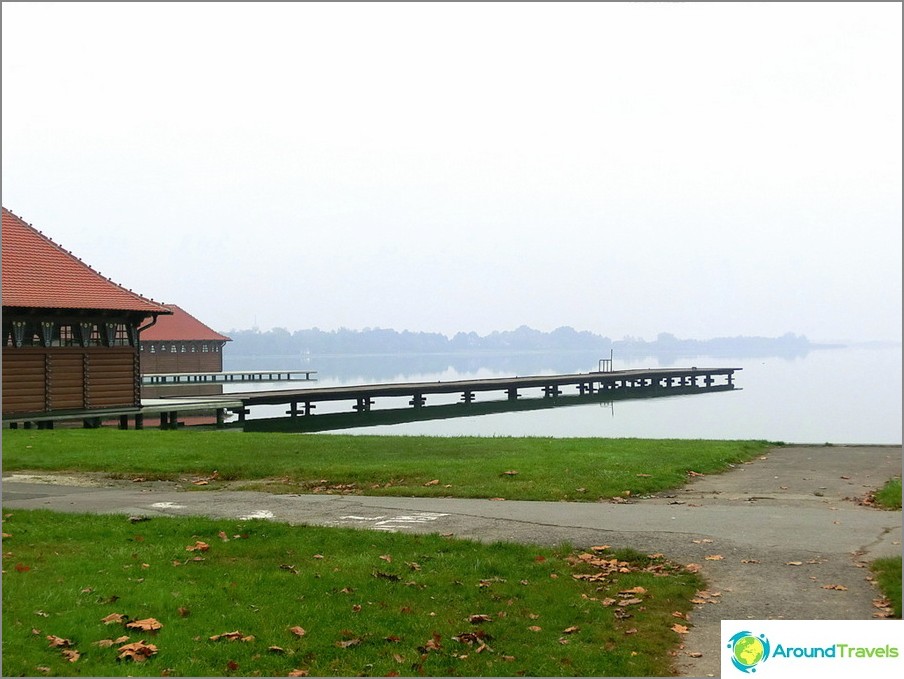
Lakes in Palic in October
But what can I say, there are good swimming pools 300 meters from our house - a complex of as many as three, where the smallest is for children, and the largest is Olympic, 50 meters high. These are open-air pools and they work most of the year, about 9 months of the year, so swimming there is as pleasant as in Thai.
Language
Thailand: Thai language is very difficult for us because of its tone. One word, pronounced with different intonation, can have several meanings..
Serbia: Serbian is similar to Russian. I can't say that everything is immediately clear, but there are a lot of similar words, since the languages are related («praise» - thanks, «we pray you» - I ask you to, «pekara» - bakery, etc.). Although not everything is the same, and you need to be careful with this., «crucian carp» grandma is here.
Learning the language is easy. Sergei now goes to Serbian courses, only 2 hours a week. Progress was already after a month of classes. For six months they promise more or less free ownership. Due to the language and due to the fact that outwardly we are not particularly different from the Serbs, it is much easier to integrate in the end here..
English can be used in both countries. Serbs quite easily switch to English, many know very well (for example, in our experience, pharmacies here always speak good English).
Climate
Thailand: The climate is tropical. Hot, humid, green all year round. True, it is too hot for young children - due to the peculiarities of heat exchange, they overheat faster, and overheating and sunburn for babies is much more dangerous than for adults.
With Sofia, we could walk either until 9 am or after 5 pm. The rest of the time we sat mostly at home, under air conditioning, although outside the window there was «summer».
Serbia: The seasons are expressed here, which is more familiar than the Thai climate, but the winters are mild, and the summer is also hot, but still, I hope, not as hot as in Thailand.
This year, snow and low temperatures (-10-15) were only a week. In November, Sofia sometimes still wore a T-shirt, spring here begins in the second half of February, and in March, they say, it's already summer.
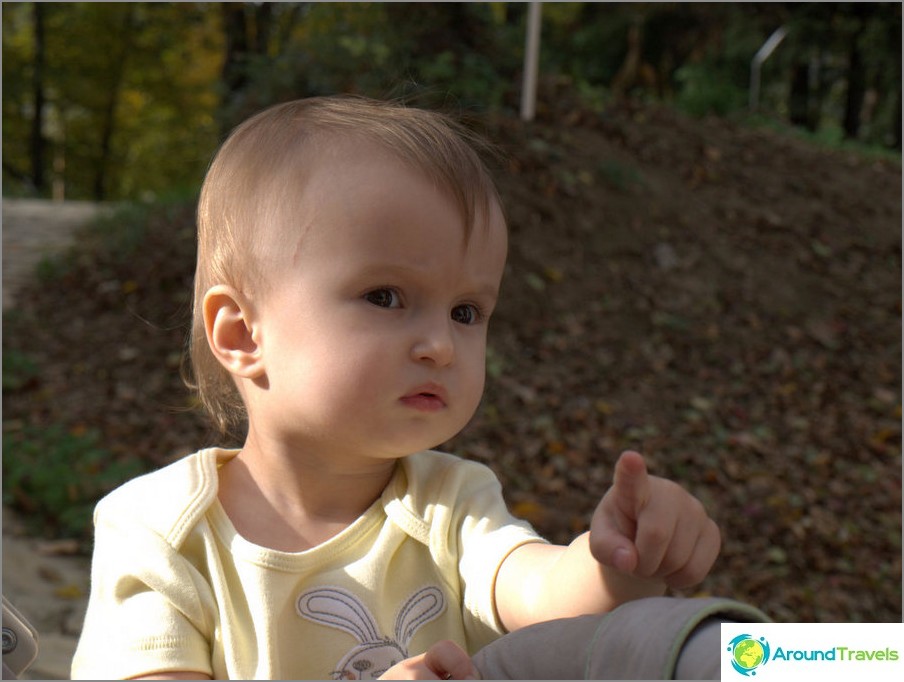
Walking around Belgrade in November. Great climate and lucky with the weather
Rainy days are quite few (sunny days, as the locals say, somewhere around 320). I can say that such a winter is not at all annoying. Local children go without hats. And summer still lasts most of the year.
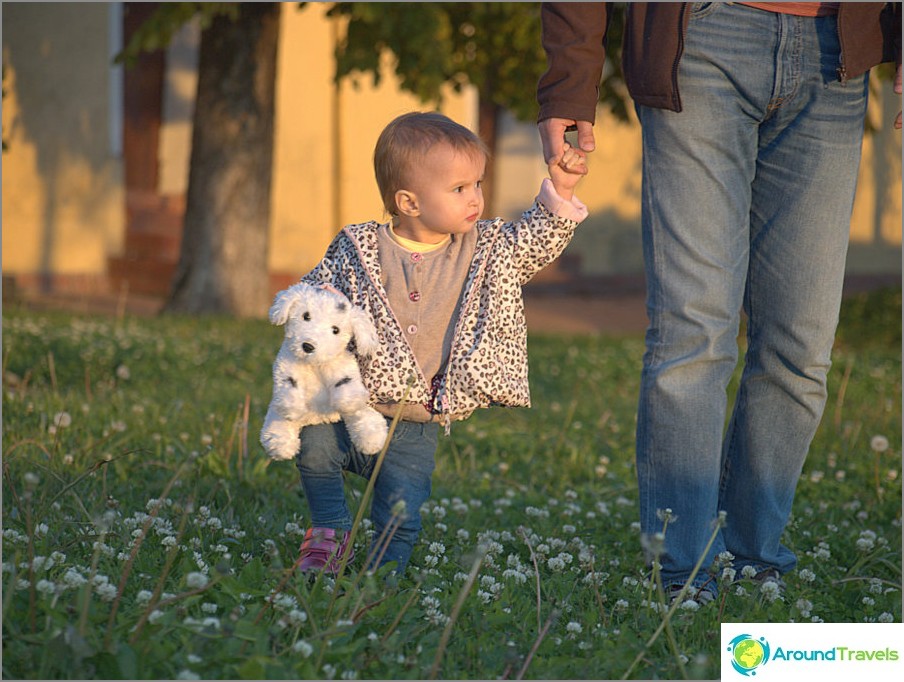
There are also mountain resorts in the country (Kopaonik, Divchibare), so in 4-5 hours you can easily get to the snow, if someone gets bored, and go for a ride. The ski resorts here are good for beginners as the trails are not difficult. And for difficult ones, you can go to the Alps, they are also close.
Attitude of local
Thailand: Thais are very friendly, they know everything. Although with little Sophia, we suffered a little from an excess of attention. In stores, they often wanted to touch her, which I did not always like.
Serbia: Serbs are open, friendly and have a good attitude towards Russians. And they just love children. With regard to the child, enthusiasm is also expressed here, but, so to speak, more delicately.
The attitude towards children is very reverent, even if it is an unfamiliar child. On the playground, Sofia is sometimes caught on some descent by a completely unfamiliar dad, if he sees that I do not have time to run. It touches me terribly every time. And I like that Sofia grows up in such an atmosphere of self-respect and mutual assistance..
And in Serbia, it seems, there are such opportunities for development for special children (relevant for Oleg and Daria).
Product quality and selection
Thailand: It was paradise for us here. A huge amount of fruits, vegetables and herbs. Almost all of us bought at Tesco, something at Macro. 99% of what I needed according to various complex recipes, I found.
Now I really miss many of the ingredients that I had time to get used to in Thailand - fresh shiitake and enoke mushrooms, black beans, coconut milk, etc..
Of the minuses, they say that there is a lot of chemistry in Thai vegetables and that rice is GMO. And many more in Thailand suffer from a lack of kefirs, simpleton milk, etc., some of them even start dreaming about it..
Serbia: Serbian products are said to be the best in Europe. Not tested all over Europe, but the products here are really very good. The country is agricultural, Serbia has no money for GMOs, and the requirements are high. Everything is very fresh and tasty.
The milk is the most real, from which sour cream and cottage cheese, yogurt, cheese, a huge number of varieties of different meats are obtained. In regular large (non-premium) hypermarkets, you can buy fresh horse meat, frozen venison or wild boar meat. This is me all to the question of diversity.
Huge selection of very good wines: French, Italian, Serbian, Montenegrin, etc. for a penny. What we like costs 4 euros, but there is also for 1.5.
Italian tomatoes and grapes are common and delicious. The standard packages contain Roquefort, as it should be from unpasteurized milk (I understand that in Russia you can now get it on the forehead for such confessions). They do not hesitate to write the percentage of meat content and its category on sausage and sausages. Highest percentage on sausages I've seen - 92%, pork and chicken.
And how do you like jam, which is 75 percent of selected plums and after opening the jar can be stored in the refrigerator for no more than a week? In general, there are a lot of perishable products here, which means they are more natural, with less preservatives. If we compare Serbian products with Thai ones, then I would say that their quality is even higher here than in Thailand, this is especially true for fruits and vegetables, with the exception that there are simply no tropical fruits in Serbia.
For lovers of buckwheat, black bread and herring, I will say that they are here, only the herring will have to be salted.
There is also street food in Serbia, and I really like it. In general, there is such an abundance in terms of food that it is simply breathtaking. There is not a single quarter in the towns where there would be no pEkara (a small bakery) where you can buy fresh croissants, burekas (a puff pastry with meat or cheese). Here is a freaky plyeskavitsa (a huge bun with a huge cutlet and salad, McDonald's is resting) and Raki.
But the products in Thailand and Serbia at least can be compared, in general, both there and there, there are a lot of good things, but I can't even come close to comparing Serbian and Russian products - there is infinity between them..
But Serbia's Huge Minus: No Durians.
Prices
Thailand: Baht is pegged to the dollar. The dollar is now growing both against the ruble and against the euro. If income is in rubles, then it is not easy in Thailand now.
Here is the budget for our last wintering: we had a rather expensive house (28 thousand), although we rented it very cheaply - the same in our village usually cost 35, and those that are larger - 45; car (12 thousand), since we did not want to carry the three-month-old Sofia on a motorbike. For everything together, including food, visas, medicine, diapers, we spent about 75 thousand baht.
Until we came to Asia with a child, I thought that everything here is very cheap. But, as it turned out, children's products, unusual for Asians, are very expensive here. Take, for example, the notorious highchair, we saw in Robinsons for 4-6 thousand baht. Diapers and clothes are very cheap.
In Thailand, there are many opportunities for a completely budgetary life, but with a child you want a little differently. And it's not cheap anymore.
Serbia: Serbian dinar is pegged to the euro. And in relation to the dollar, the euro has fallen sharply lately. Although in relation to the euro, the ruble is below the plinth. If the ruble exchange rate were the same, then everything would be very cheap. As well okay.
We buy more or less everything we want, but within reasonable limits 🙂 On food per week we spend about 100 euros, sometimes a little more, but less, probably not.
In Serbia, gasoline is expensive, but this is a common minus in Europe, probably, it is even more expensive than Thai - a liter of 95th - about 140 dinars (in euros 1.15). And quite high utility bills. I hope that for our large apartment in winter we will fit in 150 euros for everything, in summer at 50. But here you have to pay for heating, which is not in Thailand. And the most expensive option is if the house is heated with gas.
Electricity in Serbia is cheaper than in Thailand. In Thailand, we have a kilowatt of 5 baht, sometimes 4-5 thousand baht came out in a month because of air conditioners. In Serbia, a kilowatt costs 5 dinars per day and only 1 dinar (about 60 kopecks) at night (so washers, dryers, dishwashers work here at night).
Still, by European standards, prices in Serbia are low. For example, I know that people moved here from Italy (an Italian husband, a girl from Russia), including because of high prices and taxes in Italy (they called me 900 euros - rent of a kopeck piece and 250 euros - a communal apartment).
The medicine
So far, both in Thailand and in Serbia, we went only to the pediatrician..
Thailand: There are state-of-the-art hospitals here, although very expensive, and there are small private offices. For vaccinations and examination by a pediatrician in Krabi, we went to just such a small private.
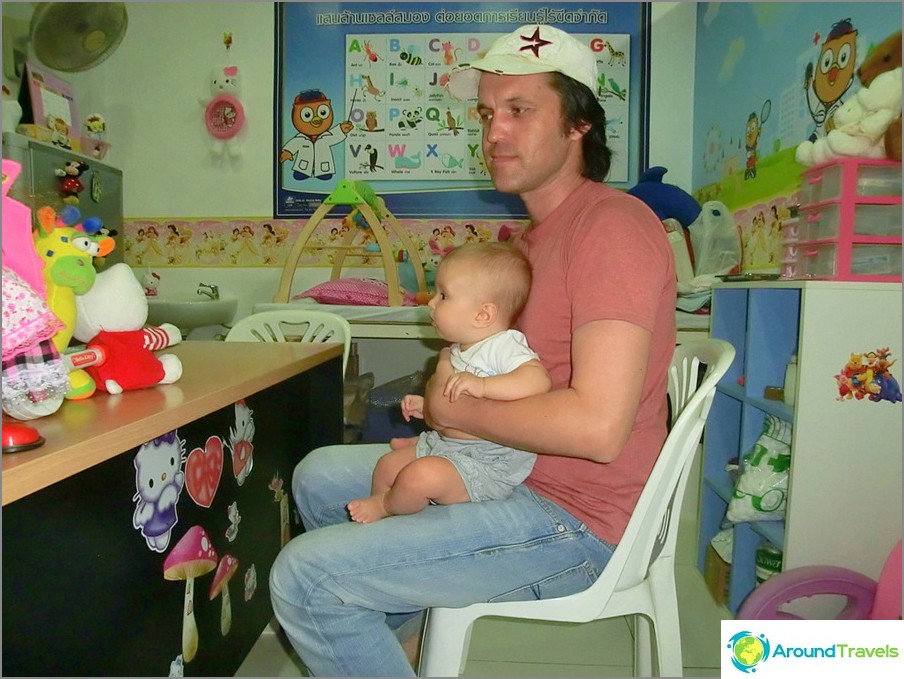
Vaccinated in Thailand
Serbia: There is probably no such level of hospitals as in Thailand, in Serbia, but there is Austria nearby with excellent medicine, for a very extreme case. State medicine, they say, is not very good here, although we have not yet encountered it in our own experience..
We have insurance, but we still take Sofia to the pediatrician in a private office. A small private clinic owned by one doctor with 40 years of experience and an ironclad reputation. It is much more convenient and humane in relation to a child than a clinic. For the price it comes out about the same as in private Thai offices. 1000 dinars first reception (8 euros) and 300 dinars subsequent (less than 3 euros).
Travel Opportunities
Thailand: Thanks to Air Asia and their promotions, it is easy and cheap to travel all over Asia.
Serbia: The possibilities of traveling in Europe are almost endless. To Budapest from us 300 km, to Vienna 450, to Venice 750, to Milan 1150. To Bosnia 40. Croatia, Montenegro, Bulgaria, Greece - everything is nearby, since Serbia is successfully located in the center of Europe. Everywhere you can get there by car, or fly off, taking advantage of some low-cost airline promotion.
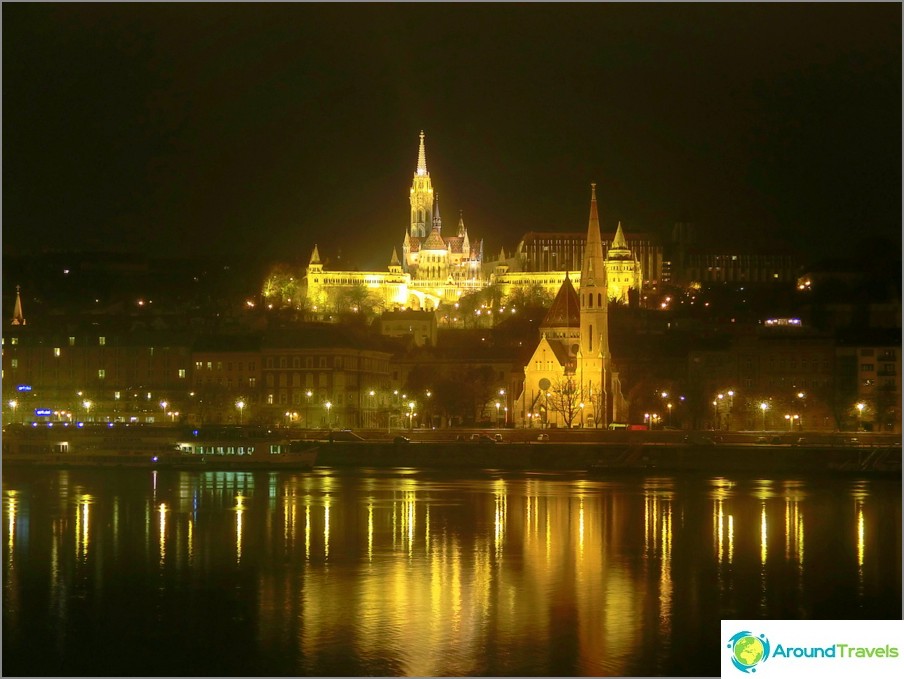
Fabulous Budapest
By its location, Serbia gives odds to all its Balkan neighbors. For example, from Montenegro and Bulgaria, the same travel by car will be more difficult - further, more expensive, through the mountains. And you can really drive from Serbia.
Distance from Russia
Thailand: There are practically no options here - the plane. Fly approximately 9 hours. Air sales shows that tickets now cost around 30,000 (you can also check the price on Skyscanner.com).
Serbia: Here you have a choice: fly in by plane, take a train, take a car. If you fly, then compared to Thailand, it is not long at all - 3 hours. And cheaper, at least twice.
In addition, there is a large hub nearby - Budapest, from where the low-cost airline Wizzair flies. I saw tickets for a promotion for 77 euros from Moscow and back, but even without a promotion with a discount card of this airline, you can find tickets with a cost of less than 100 euros there and back.
The train journey to Budapest costs 15 euros, you can also go by car, and then leave it at the cheap Wizzair airport parking lot. But you only need a Schengen visa.
Cons of Serbia
If you really want to travel around Europe and at the same time get permanent residence, you will have to look for a compromise: you can only be absent from Serbia 2 months a year.
The state of the economy is not brilliant, as they say, but if you look at the facts, then in terms of growth rates the country will take second place in the region after Montenegro in a year, and, which came as a surprise to me, it is overtaking both Croatia and Slovenia..
Due to the fact that the country is not rich, the asphalt is not very good in places and not all buildings have been repaired, but in general they are comfortable. In Russia, in some places there is such devastation that the Serbian is just a kindergarten against its background. So it is also not a minus critical. But compared to Thailand, cities are much cleaner, trash cans and trash cans are there, there is a sidewalk, and I have never seen rats here..
The country is not in the EU or Schengen, so you need to get a Schengen visa. Having a residence permit, you can get it in Serbia. Inconvenient, but not critical.
Another noticeable disadvantage is audibility in apartments. Here and there strong, here and there hellish. But here it is important to choose the right apartment, we prefer the top floors and corner apartments.
Graffiti on the walls of Serbian houses. Not pretty. But we have already stopped paying attention to them..
No Ikea. It will be built only in 2 years. In some things, she really lacks, especially when you need to buy quickly and familiar, and, for example, there is no desire to study the assortment of new stores for a long time. Here they carry from Hungary to order from a catalog for a frantic commission of 40-50 percent to the catalog price. True, this includes assembly, but no discount is given for refusing to assemble. For something small in Ikea, you can go yourself. But how to bring a sofa?
Wintering VS moving
It may seem that I am comparing two incomparable things: wintering and moving. But in reality, everything is simpler than it might seem. Now in such moves there is no drama, the work is still the same, remote, relatives and friends are still on Skype. Only an apartment and a car moved with us, and that's it..
But life has become easier, there is no need to think about visas, leaving the country, letting in or not letting go back, etc. And also, given the current ruble exchange rate, the fact that we live in our own apartment and use our car makes life a lot easier. There is no need to worry that if the ruble rate moves further, it will become even more difficult. So a simple rational decision.
If we take precisely monetary relations, then we can always make money on food and utilities, on travel too, since from here they cost us much cheaper.
And, whatever one may say, life in Thailand was wonderful, but by way of life, mentality, habits and interests we are Europeans. And here, in a sense, it's even safer for me to be at home, I know that no one will crawl in, we have this happened in Asia more than once, and there is no need to hide sugar in the refrigerator from ants. Although we have not stopped loving Asia.
By and large, both countries are very good. And each has its own set of requirements. In our opinion, Serbia is now ideal for us for immigration.
